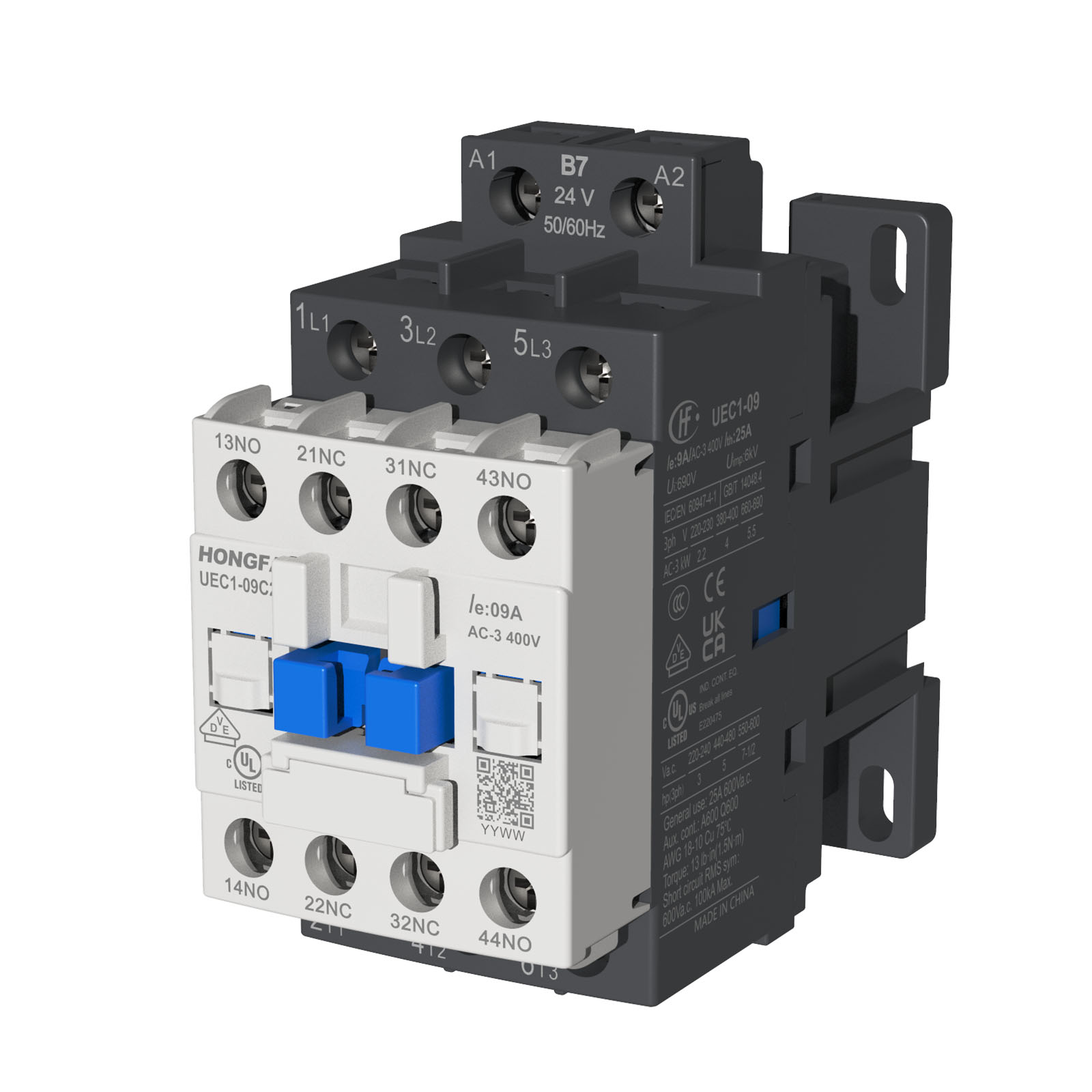Low-voltage electrical components are an indispensable part of the power system. They ensure the safety and reliability of industrial and household electricity by precisely controlling and protecting circuits. This article will explore three commonly used low-voltage electrical components: contactors, current transformers and thermal relays, and analyze their functions, working principles and their importance in the power system.

AC Contactor UEC1 series
Contactor
It is divided into AC contactors (voltage AC) and DC contactors (voltage DC), which are used in power, power distribution and power consumption. Contactors generally refer to electrical appliances in industrial electricity that use coils to flow current to generate a magnetic field to close the contacts to control the load.
The difference between AC contactors and DC contactors
1. The iron core is different: the iron core of the AC contactor is made of insulated silicon steel sheets stacked together and made into a double E shape; the iron core of the DC contactor is mostly made of a whole piece of soft iron, mostly in a U shape.
2. The arc extinguishing system is different: the AC contactor uses a chip-deleting arc extinguishing device, while the DC contactor uses a magnetic blow-out arc extinguishing device.
3. The number of coil turns is different: AC contactors with fewer coil turns are connected to AC power, while DC contactors with more coil turns are connected to DC power. AC contactors break AC circuits, while DC contactors break DC circuits. The maximum operating frequency of AC contactors is 600 times/hour, and the cost of use is low. The operating frequency of DC contactors can be as high as 2000 times/hour, and the cost of use is high.
4. The fault of wrong power connection is different: If the AC and DC contactors are connected incorrectly, that is, DC is connected to the AC contactor, the coil will burn immediately; and AC is connected to the DC contactor, the contactor cannot be attracted.
The role of the contactor
Because it can quickly cut off the AC and DC main circuits and can frequently connect and control the circuit with large current (some types can reach 800 amperes), it is often used in motors as control objects, and can also be used to control power loads such as factory equipment, electric heaters, machine tools and various power units. The contactor can not only connect and disconnect the circuit, but also has a low voltage release protection function. The contactor has a large control capacity and is suitable for frequent operation and remote control. It is one of the important components in the automatic control system.
Working principle of contactor
When the contactor coil is energized, the coil current will generate a magnetic field. The generated magnetic field causes the static iron core to generate electromagnetic attraction to attract the moving iron core, and drives the AC contactor to move, the normally closed contact is disconnected, and the normally open contact is closed. The two are linked. When the coil is de-energized, the electromagnetic attraction disappears, and the armature is released under the action of the release spring, so that the contacts are restored, the normally open contacts are disconnected, and the normally closed contacts are closed. The working principle of the DC contactor is somewhat similar to that of the temperature switch.
Thermal relay
The working principle of the thermal relay is that the current flowing into the thermal element generates heat, causing the bimetallic strips with different expansion coefficients to deform. When the deformation reaches a certain distance, it pushes the connecting rod to disconnect the control circuit, thereby causing the contactor to lose power, the main circuit to disconnect, and the motor to achieve overload protection. As an overload protection element for motors, relays have been widely used in production for their small size, simple structure, and low cost.
Parameters of thermal relays
Rated voltage: The highest voltage value at which the thermal relay can work normally, generally AC 220V, 380V, 600V.
Rated current: The rated current of the thermal relay mainly refers to the current passing through the thermal relay
Rated frequency: Generally speaking, its rated frequency is designed according to 45~62HZ.
Setting current range: The range of setting current is determined by its own characteristics, which describes the thermal relay under certain current conditions.
Selection of thermal relays
1. The selection of thermal relays should be equal to or greater than the rated current of the motor.
2. The rated current of the thermal relay = (0.95-1.05) times the rated current of the motor.
3. When the ambient temperature around the thermal relay is not 35℃, it should be set to: (95-T)/60 square root of the quotient T: ambient temperature.

AC Contactor UEC1 series
By deeply understanding the working principles and functions of contactors, current transformers and thermal relays, we can recognize their key role in the power system. These components not only improve the automation level of the power system, but also enhance the safety of the system. The correct selection and application of these low-voltage electrical components are crucial to maintaining the stable operation of the power system.
Post time: 7 月-22-2024


